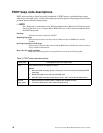
61
Troubleshooting charts
The following tables list problem symptoms and suggested solutions. See the blade server Hardware
Maintenance Manual and Troubleshooting Guide on the Intel Server Compute Blade SBX82
Resource CD for more detailed troubleshooting charts. If you cannot find the problem in these
charts, run the diagnostic programs.
Memory problems
Processor problems
Symptom Suggested action
The amount of system
memory displayed is less
than the amount of
physical memory installed.
Make sure that:
• The DIMMs are seated correctly.
• You have installed the correct type of memory.
• If you changed the memory, you updated the memory configuration in the
Configuration/Setup Utility program.
• All banks of memory are enabled. The blade server might have
automatically disabled a memory bank when it detected a problem, or a
memory bank might have been manually disabled.
Check the POST error log for error message 289:
• If the DIMM was disabled by a system management interrupt (SMI), replace
the DIMM.
• If the DIMMs are not installed in pairs, install DIMMs starting with DIMM 1
and DIMM 2. Make sure there is not an unpopulated DIMM slot in the
middle and make sure DIMM 3 and DIMM 4 are installed before DIMM 1
and DIMM 2
• If the system halts, make sure the DIMMs are installed in dual-ranked pairs.
Swap DIMM 3 and DIMM 4 with DIMM 1 and DIMM 2.
• If the system error indicates an unsupported memory configuration, make
sure there is more than one DIMM installed. Install DIMMs in DIMM slots 1
and 2. If this does not correct the error, replace the DIMMs flagged in the
management module log and indicated through the Light Path Diagnostics
LEDs.
• If the DIMM was disabled by the user or by POST, run the
Configuration/Setup Utility program and enable the DIMM.
• If this error remains, replace the DIMM.
Symptom Suggested action
The blade server emits a
continuous tone during
POST.
The startup (boot) processor is not working properly.
Make sure that the startup processor is seated correctly. If it is, replace the
startup processor.


















